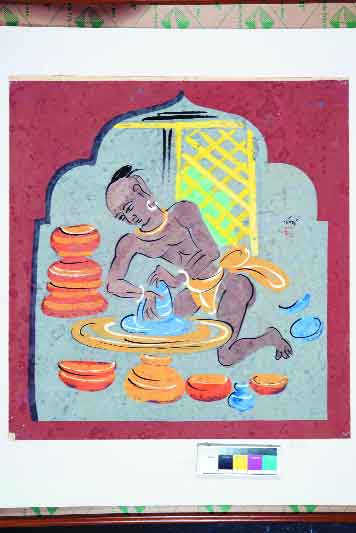The India Pavilion at the Venice Biennale will look at historical works and issues like nationalism and peace through the prism of modern times. By Uma Nair
The Universe has come out of Ananda (supernal delight),” says the Upanishad. This delight includes and transcends all joys and sorrows with Nandalal Bose’s Haripura posters that are full of nationalist spirit and fervour.
“Nandalal and his associates produced around 400 posters for the Congress convention at Haripura, held in February 1938,” reflects Director General of NGMA, Adwaita Gadanayak. He is upbeat about India’s participation at the Venice Biennale where he is celebrating 150 years of Gandhi with an exposition of the Haripura posters by Nandalal from NGMA’s collection. Earlier, in August 2017, Gadanayak celebrated 70 years of Independence, when he hosted an exhibition that sought to awaken our political consciousness and included the historic Haripura posters that were a joy to behold because it awakened our political consciousness at large.
“At the Venice Biennale we will display them as independent works but history says they were done to decorate a temporary township built for the annual session of the Indian National Congress in the remote village of Haripura in early1938,” adds Gadanayak.
According to historical notes by art historian R Sivakumar the township was built of local materials and in harmony with the rural surroundings. The decorations were conceived, both in style and idiom, following the same aesthetics and were designed to complement the temporary structures. Sivakumar wrote in an essay that they have to be imagined in their original context as part of a total design to be fully appreciated. Viewed in this manner their nuanced sophistication, which is characteristic of Nandalal, comes to the fore.
NATIONALISTIC FERVOUR
“These posters were all produced on handmade paper with pigments ground from local earth and stones, and mounted on straw boards; none were printed or mass-produced,” he adds.
These posters reflect the painter’s acute sensitivity to the landscape and village folk around him. Each poster is a validation of vitality and liveliness more than 70 years after they were executed.
They depict genre scenes within arched niches and these appear like windows into vignettes of Indian village life.
When one imagines that they were executed in 1937 after being commissioned by Gandhi for the Indian National Congress Party meeting in Haripura in 1938 – these can certainly be considered a benchmark in Indian history. With subjects like an esraj player, a veena player, women doing their chores, Nandalal brings an authenticity and sincerity through his choice of materials and techniques by ensuring their quality which is non-derivative from Western models. The fluidity of contours and the weaving in of colour tones in the images that personify the rural idyll are a lesson in the roots of modernism.
Bull Fighter
In the Bull Fighter, the vigour and tenacity of the man and the bull are shown through strong, gestural lines and swathes of bright, bold colours. The Bull Fighter was prominently displayed at the conference grounds at Haripura. It also resonates with older styles that add myriad meanings.
Deceptively simple in appearance and invoking folk paintings the Haripura Posters are an amalgam of the decorative and the calligraphic.
Gandhian ethics andcreativity
Haripura was the crowning glory of Nandalal’s association with the Mahatma and his experimentation with Gandhian ethics in creativity, which had begun at the Lucknow session of the Congress in 1936 and taken a definitive shape at Faizpur in 1937. In this context Gandhi’s assessment of Nandalal’s achievements while inaugurating the exhibition at Faizpur is worth quoting.
He said, “Credit for the arrangements here belongs to the architect, Mhatre and the artist, Nandalal Bose. When Nanda babu responded to my invitation a couple of months back, I explained to him what I wanted, and left it to him to give concrete shape to the conception. For he is a creative artist and I am none. God has given me the sense of art but not the organs to give it concrete shape. He has blessed Nandalal Bose with both. I am thankful that he agreed to take upon himself the whole burden of organising the artistic side the exhibition. He came and settled here some weeks back to see to everything himself. The result is that the entire Tilaknagar is an exhibition in itself, and so it begins not where I am going to open it, but at the main gateway which is a fine piece of village art. Of course our thanks are due also to Mhatre who has spared no pains in bringing the entire plan to completion. Please remember that Nanda babu has depended entirely on local material and labour to bring all the structures here into being.” (Quoted from, Collected Works of Mahatma Gandhi, digital edition, Vol. 70. Page 212.)
Gandhi’s Letter to Hitler
The Indian Pavilion will also have Jitish Kallat’s immersive and historic Covering Letter: Projection of Gandhi’s Letter to Hitler. Projected onto a traversable curtain of cascading fog, this work presents a historical letter by Mahatma Gandhi to Adolf Hitler, written just weeks before the start of World War II. In the spirit of his doctrine of universal friendship, Gandhi begins the letter with the greeting “Dear friend.” Mist diffuses Gandhi’s projected text, echoing the fate of his message, which went unheeded.
Kallat says, “This describes Gandhi’s correspondence as a plea, it is from a great advocate of peace to one of the most violent individuals who ever lived. I also imagined it as an open invitation for self-reflection, as its scrolling words speak to the extreme violence in the world today.” Kallat’s interest in remediating history through the actions and words of historical figures places this piece among the most avant garde works of practicing contemporary artists in India. In unveiling Covering Letter, in Venice on May 11, the artist focusses on the possibility of peace and tolerance in a world plagued by control and surveillance.


























